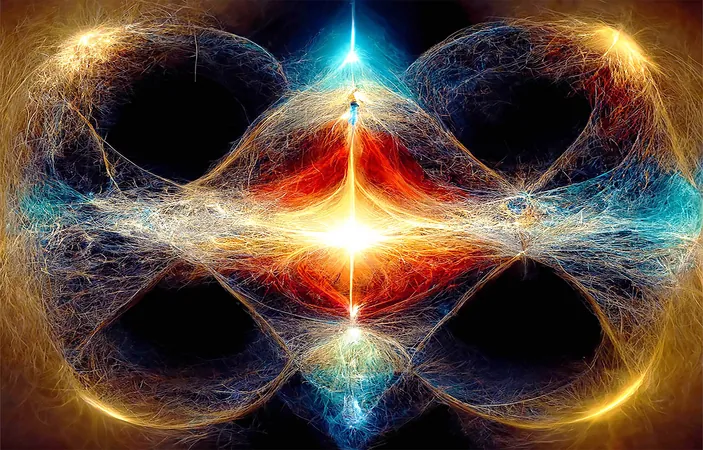
Is Consciousness Everywhere? Exploring the Groundbreaking Theory of Panpsychism
2025-05-19
Author: Kai
Rethinking Consciousness
Traditionally, consciousness has been viewed primarily as a human-exclusive phenomenon, intricately linked to our brains and behavior. However, for centuries, thinkers have pondered whether consciousness extends far beyond human experience, possibly permeating the very fabric of reality itself.
Enter Panpsychism
This intriguing theory, known as panpsychism, suggests that all elements of the universe, no matter how minute, possess some degree of consciousness. As researchers grapple with the perplexing question of how physical matter gives rise to subjective experience, the idea that awareness could exist in various forms throughout nature is gaining renewed attention.
A Historical Perspective
The notion of consciousness existing in all matter is not new. Even back in the 6th century B.C., Thales of Miletus suggested that magnets might possess souls due to their ability to attract iron. Anaxagoras later claimed that "everything contains a portion of mind," echoing modern discussions about micro-experiences that accumulate to create richer consciousness.
Throughout history, thinkers like the Greek Stoics and Plotinus have contributed to this idea, pondering whether the universe itself is alive and interconnected through a rational essence.
Revisiting Old Ideas
During the Enlightenment, René Descartes famously separated mind from body. Yet, Gottfried Wilhelm Leibniz proposed that 'monads'—indivisible units reflecting the universe—could harbor their own perceptions. The late 19th century saw philosophers like William James advocating for a view where consciousness is woven into the very fabric of nature, not just perched atop it.
Modern Neuroscience and Consciousness
Today, innovative theories like Giulio Tononi’s Integrated Information Theory (IIT) are tackling the age-old question of consciousness. Tononi posits that the degree of consciousness in any system correlates with how much integrated information it generates. This approach opens the door for consciousness to exist in diverse entities—be it animal brains, artificial intelligence, or even inanimate matter if the right informational structure is present.
The Quantum Conundrum
The intersection of philosophy and quantum mechanics is yet another pathway exploring consciousness. The Orch-OR theory, proposed by physicist Roger Penrose, posits that consciousness arises from quantum activities in the brain. While critics argue that the conditions in the human brain are unsuitable for prolonged quantum states, supporters point to emerging evidence of quantum phenomena in biological processes.
Why It Matters
Critics of panpsychism raise concerns that attributing consciousness to fundamental particles dilutes its meaning. One significant challenge that remains is the 'combination problem': how do countless microscopic experiences amalgamate into the rich tapestry of human consciousness? Despite these debates, panpsychism's enduring allure offers a fresh lens through which to view the mind-matter relationship.
The Road Ahead
The future of panpsychism hinges on ongoing research that sharpens our understanding of consciousness. As neuroscientists continue to refine their measurements and physicists investigate the quantum underpinnings of life, philosophers are revisiting ancient concepts with a modern twist.
Ultimately, this quest illustrates a stunning possibility: consciousness might not be a rare occurrence but rather a fundamental feature woven into the cosmos. Rather than seeking to endow non-living things with minds, the challenge ahead is to decode how simple experiences converge to create the rich, compelling symphony of consciousness we observe in daily life.



 Brasil (PT)
Brasil (PT)
 Canada (EN)
Canada (EN)
 Chile (ES)
Chile (ES)
 Česko (CS)
Česko (CS)
 대한민국 (KO)
대한민국 (KO)
 España (ES)
España (ES)
 France (FR)
France (FR)
 Hong Kong (EN)
Hong Kong (EN)
 Italia (IT)
Italia (IT)
 日本 (JA)
日本 (JA)
 Magyarország (HU)
Magyarország (HU)
 Norge (NO)
Norge (NO)
 Polska (PL)
Polska (PL)
 Schweiz (DE)
Schweiz (DE)
 Singapore (EN)
Singapore (EN)
 Sverige (SV)
Sverige (SV)
 Suomi (FI)
Suomi (FI)
 Türkiye (TR)
Türkiye (TR)
 الإمارات العربية المتحدة (AR)
الإمارات العربية المتحدة (AR)